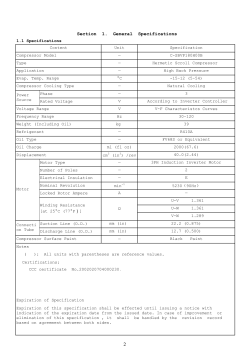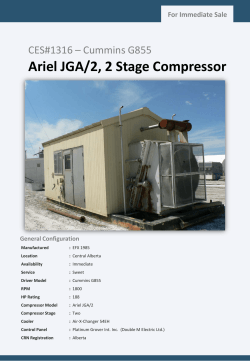
History of High-Speed Technology in Finland
History of High-Speed Technology in Finland Jari Backman Jaakko Larjola LUT School of Energy Systems 2 6.6.2015 Introduction High-Speed Technology means a system, where the electric machine (motor or generator) and the turbo machine (turbine, compressor or pump) are connected together directly without a reduction gear, and where the rotational speed of this common rotor is bigger than the synchronous speed (3000 rpm in the 50 Hz network). Typically this speed is over 10 000 rpm. In Finland there has been a great number of high-speed technology research projects, in co-operation of LUT, the Aalto University and industrial enterprises since 1981. This development is described in this presentation. 6.6.2015 LUT School of Energy Systems 3 In the beginning … 1976 Prof. S.S. Wilson from Oxford presented the idea of a household ORC mini power plant in a conference in Copenhagen. Jaakko Larjola liked it and got Prof. Pertti Sarkomaa interested and they applied funding from the MTI to build a prototype for a 30 kW ORC turbo generator. Funding was granted 15.2.1981. For the generator design Prof. Lauri Aura, who recruited his colleague Prof. Tapani Jokinen from Aalto University. The practical work on the most innovative part, gas bearings, were in the hands of technicians Ilpo Taipale and Jouni Ryhänen. Later, they were awarded the Skilled Expert Prize in 1982. 6.6.2015 LUT School of Energy Systems 4 First Press Conference and more funding The 30 kW high-speed turbo generator and feed pump facility was tested in 1982 and functioned with promising results (speed 30 000 rpm). LUT organized a press conference, where the expected advantages of the ORC Power Plant were such a success that the Director of Energy Department Seppo Hannus and Inspector Pertti Laine from MTI granted funding to build the actual prototype. During this same time the term high-speed technology was launched in Finland. With the 100 kW test facility Esa Vakkilainen and Olli Lindgren started their research careers. 6.6.2015 LUT School of Energy Systems 5 Companies are interested In 1981 Larjola got a recommendation from MTI to start patenting the high-speed turbogenerator, which later became three patent applications. The funding to this work came from the Foundation of Invention (Keksintösäätiö), and the main patent was granted also internationally. To cover they costs the FI marketed the invention to the industry and the CTO Pekka Kunttu from the Kuopio based Saastamoinen Oy travelled to Lappeenranta to negotiate about commercialization process. 6.6.2015 LUT School of Energy Systems 6 ORC and Industry Before the 100 kW test facility was in operation, Saastamoinen Oy started the follow-up project to build a new 100 kW power plant into the industrial environment, to make electricity from the waste heat at Saastamoinen Oy Rauhanlahti sawmill. The split turbogenerator is on display in the LUT corridor. 6.6.2015 LUT School of Energy Systems 7 Research portfolio grows The research at LUT advanced also on other sectors: The compressor prototype (Jari Backman and technician Pekka Eskelinen) and one of the first frequency converters (Reijo Päivinen) were developed in a Tekes project in 1983-84. The construction of the compressor was ready first and without a frequency converter it was run at Aalto university with a 500 Hz motor-generator set. In 1983 a 5 kW, 150 000 rpm motor (Juha Pyrhönen) with gas bearings (Jaakko Larjola) was developed. This is still in operation and demonstrates the high-speed technology in the laboratory for visitors. Gas and liquid bearing modelling was started (Petri Sallinen). 6.6.2015 LUT School of Energy Systems 8 Industrial compressor trial The first effort to develop a commercial product was made by Korpivaara-Hydor (Jouko Peussa, Mauri Airila) (company is today Sarlin). The target in 1986 was to make a compressor for pneumatic transport. The key players were Jouko Peussa, Jukka Peltola and Pertti Sormunen in Vantaa and Jari Backman as well as Pekka Eskelinen were hired to work at LUT. Two working prototypes were done and a high-pressure concept was in mind, but after 30 months it was clear that the frequency converter technology was not yet ready. The first prototype was run with a 700 Hz synchronous generator designed by Juha Pyrhönen. The first axial magnetic bearings were developed by Olli Lindgren (PID) and Mikko Paavoseppä (adaptive control). 6.6.2015 LUT School of Energy Systems 9 High-speed technology concept To our best knowledge the conference publications in 1984 ja 1986 were the first in the world to launch the concept of High-speed technology to cover all applications, where the high-speed turbo machine and the electric machine are connected without the gear box, and where the electric machine is connected to the grid with a frequency converter. 6.6.2015 Larjola J.: High-Speed Turbomachinery and Its Application in the Conversion of Energy. ASME Winter Annual meeting, Anaheim, USA, December 7 –12, 1986, ASME publ. 86WA/FE-4, 1986. Larjola J.: ORC-plant with high-speed gas lubricated turbogenerator. VDI-Berichte 539: ORC-HP-Technology (proceedings of VDI-Seminar: ORC-HP-Technology, September 10 –12, 1984, ETH Zurich), pages 697 –705, Dusseldorf 1984. LUT School of Energy Systems 10 Rauma-Repola and ORC The Oceanics Unit from Rauma-Repola Oy got interested in the ORC process as they needed a small power plant that could be operated in the deep sea conditions. Oceanics was manufacturing two deep sea submarines to the Science Academy of Soviet Union. These submarines were able to operate at the depth of 6 000 m and were later used in the popular Titanic movie. The presentation of the Kuopio ORC plant convinced Oceanics, and RR ordered the 25 kW power plant. It was developed with the work of many researchers (Jaakko Larjola, Per-Holger Sahlberg, Jukka Lattu among others), but Jarmo Alamäki was in charge of the work. 6.6.2015 LUT School of Energy Systems 11 Conference on High-Speed Technology and establishment of HST First International Conference on High Speed Technology was organized at LUT in August 1988, and there were 72 experts from 12 countries. Also commercial patterns developed: Pekka Kunttu, Jaakko Larjola, Seppo Sulkakoski and Tapani Jokinen established High Speed Tech Oy on 12.10.1988. The company was first only on paper, but there was eager quest for financing. 6.6.2015 LUT School of Energy Systems 12 Rauma-Repola to finance High Speed Tech, aeration compressor becomes the first product During the deep sea project Larjola got the management of the Oceanics to start the operation of High Speed Tech. 1990 Rauma-Repola acquired all the stocks of High Speed Tech and Kauko Helevirta started as the first CEO and had assistance from Pekka Maunumäki and Jaakko Säiläkivi. From LUT Timo Kytömäki, Jarmo Alamäki, Pekka Sahlberg, Hannu Esa, Olli Lindgren and from HUT Juha Saari, Erkki Lantto and Ville Tommila among others started to work in HST. The company first concentrated to develop a high-pressure pump and after few years MSc Timo Kytömäki discovered the concept of high-speed aeration compressors, which even today is the main product of the company. 6.6.2015 LUT School of Energy Systems 13 References a key to get ORC interesting There were many endeavors to get ORC commercialized in Finland, and the deal with Wärtsilä was almost successful. At the end of 90’s Tri-O-Gen B.V. from Holland was very enthusiastic about the process and made an agreement with HST and LUT. The implementation of the 160 kW prototype turned out to be a considerable challenge for the LUT design team as well as for LUT machine shop. Today the power plant is in use in the landfill site of Groningen and produces electricity by using waste gas as fuel. 6.6.2015 LUT School of Energy Systems 14 References a key to get Sundyne interested The interest for developing the high-pressure (9 bar abs.) compressor resurfaced in 2002. Sundyne Corporation (Bill Mabe and Juha Saari) commissioned the research, where Jari Backman, Arttu Reunanen, Hannu Esa and Teemu Turunen-Saaresti made the first design for the 300 kW high-speed compressor, HST provided the electric motor and the AMB bearings. The technicians Petri Pesonen, Juha Haikola and Erkki Nikku were in the key role to build the test facility. The prototype (at least three versions) was developed in less than five years to a commercial product that has an exceptionally high power-todensity ratio in the electric machine. It also is the quitest compressor in the market. 6.6.2015 LUT School of Energy Systems 15 High-speed technology products 1 Aeration compressor is the main product of HST (later Cardo Production Finland Oy, today Sulzer Pumps Finland Oy). The annual production volume is 150… 200 units and the product is exported to 20 countries (total volume by the year 2010 was over 1000 compressors). The compressor is using active magnetic bearings and it’s selling points are the very small need of service and the long operational life. A major part of the work for the HST success was perhaps done by the third CEO, Heikki Kellomäki. High-pressure compressor Quantima is the product of compare that was developed by Sundyne in cooperation with LUT and HST. The compressor is based on the similar technology as the HST compressors and it produces oil-free pressurized air (8 bar gauge). 6.6.2015 LUT School of Energy Systems 16 High-speed technology products 2 The ORC power plant is the most longterm development project by LUT and HST, which finally was commercialized by the Dutch TriO-Gen B.V. So far, the company has delivered 26 units, and the prospects are promising. Many parts of the power plant such as the heat exchangers (Vahterus), frequency converters (Vacon) and electric rotors (HST) are made in Finland. The ORC is capable of producing electricity from waste heat in the industry (exhaust gases from reciprocating engines), bio gas, bio mass and land fill gas. The major selling points are low service need and the long operational life thanks to the medium lubricated and hermetic high-speed generator. The engine behind Tri-O-Gen is Prof. Jos van Buijtenen. 6.6.2015 LUT School of Energy Systems 17 High-speed technology products 3 MAN is manufacturing large gas compressors with high-speed electric machines designed and made by the cooperation of LUT and The Switch (Juha Pyrhönen). The typical power of the compressor is 8 to 10 MW, in some applications even 18 MW. Vacuum compressor is the product of the Ecopump Oy (Jouni Mussalo, Juha Karvinen), today Runtech Systems Oy. The main application is in paper mills, where it replaces traditional, low efficiency water ring pumps. The production volume tallies over 500 units and compressors are exported to numerous countries. 6.6.2015 LUT School of Energy Systems 18 High-speed technology products 4 A revolutionary gas turbine concept. Electric power 450 kW, 33 000 rpm and exceptionally high efficiency. Developed by Aurelia Turbines Oy (Matti Malkamäki, Toni Hartikainen) in co-operation with LUT. Also, Green Campus Innovations is a shareholder in the company. In operation 2015 6.6.2015 LUT School of Energy Systems 19 LUT School of Energy Systems Annual high-speed technology research budget annually 1 - 2 M€. Researchers 30 persons with a significant level of experience and knowledge. Dissertations around two per year. 6.6.2015 LUT School of Energy Systems 20 Academic figures LUT + Aalto University 1981- 2009 − − − − 24 doctoral degrees (2010…2015 about 10) 47 peer-reviewed publications (2010…2015 about 25) 136 international conference publications (2010…2015 about 25 ) 35 patents (2010…2015 about 10 - 15) Public funding Tekes (eg. Lauri Ala-Opas), Academy of Finland and earlier MTI High-speed technology business with all subcontractors is estimated to 70….90 persons with an annual turnover of 20…25 M€. 6.6.2015 LUT School of Energy Systems 21 Important Observations Distribution of responsibility and profit is extremely crucial. Media publicity can be helpful especially in the application stage. Company partners are a must. Start-up focuses the operation, but there has to be a well-established sponsor (Rauma-Repola, Wärtsilä etc.). Technically a good idea and mastering the technology is not enough, the commercial process requires professional skills with appropriate funding. (Kellomäki). Concatenation: to secure funding and new projects it is important to have references and successful marketing. 6.6.2015 LUT School of Energy Systems 22 Further info (in Finnish): Larjola, Arkkio, Pyrhönen (ed.): Suurnopeustekniikka. Yliopistopaino, Helsinki 2010 (2. painos, 163 s.) 6.6.2015 LUT School of Energy Systems 23 Thank you for attention! 6.6.2015 LUT School of Energy Systems 24
© Copyright 2025











